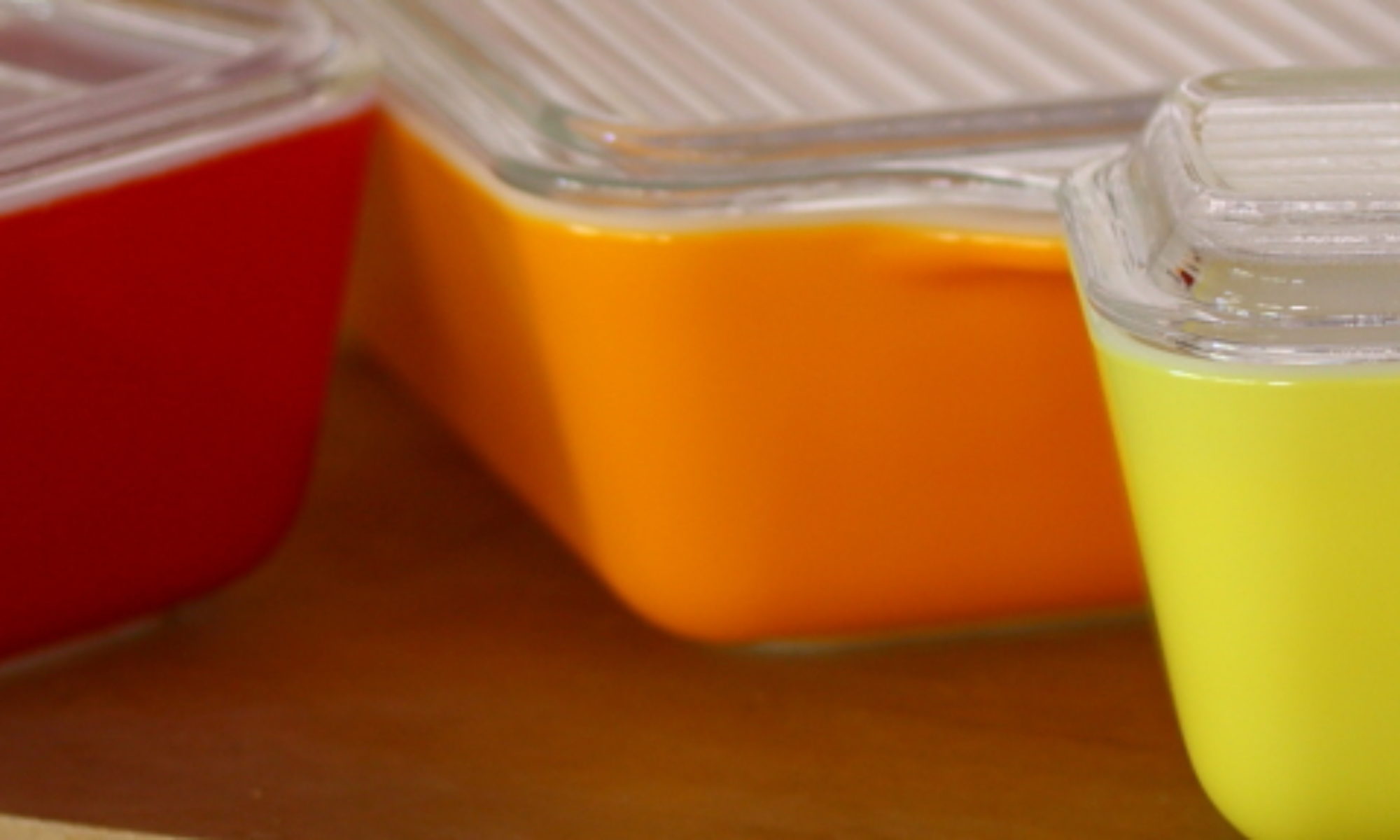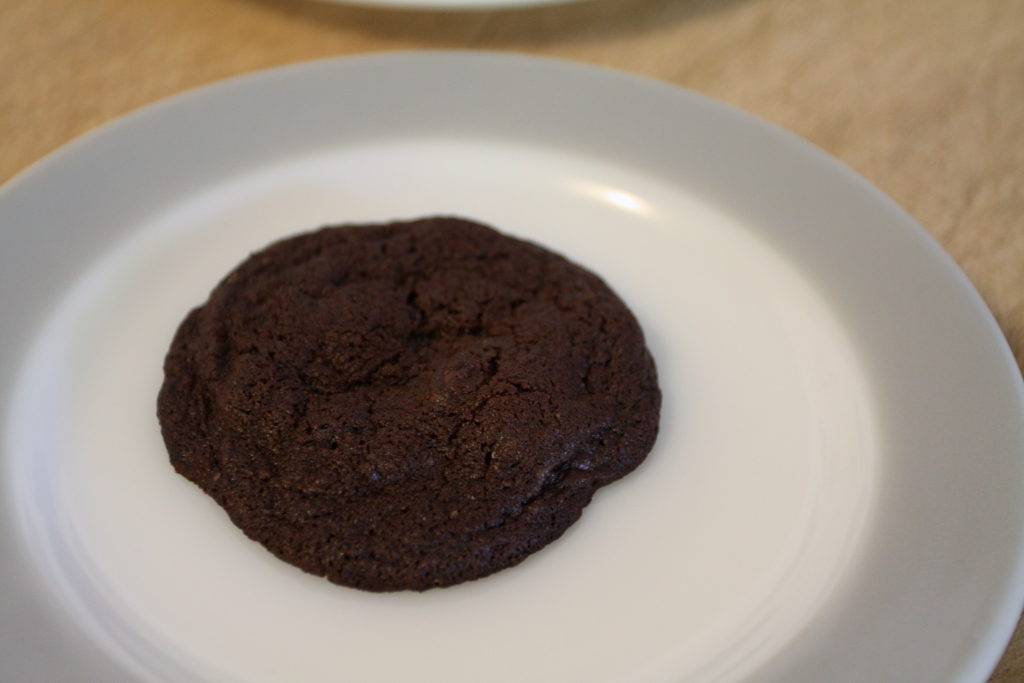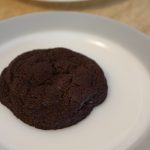
Do you remember years ago when the rumor went around about some department store’s cookie recipe? Something about a patron being charged a huge amount of money after requesting the recipe after tasting the chocolate chip cookie. It seems laughable that people fell for that one. But, to us, what’s most remarkable is that it was quite commonplace to get something to eat in department stores. Now, we aren’t talking fine dining, but we aren’t talking fast food, either. Instead, we’re talking about pretty decent, freshly-made food. Including cookies.
Now, if you’re wondering whether these cookies have some sort of outrageous price tag attached to the recipe, be assured that they do not. While we’ve moved away from department stores baking cookies, we’ve also moved away from the idea of a secret recipe for baked goods. Nowadays, chefs are providing recipes for many, many, of their products, so you can try making them at home.
This particular cookie recipe comes from Bouchon Bakery, by Thomas Keller and Sebastian Rouxel, and, according to the introduction, this is the exact recipe that they use at the Bouchon Bakeries, just scaled down for home use, although we didn’t quite follow it exactly; you’ll see what we mean. We’ve recently re-checked out the book from the library. We’d made several of the recipes from it — all turned out perfectly — and we thought it wouldn’t hurt to look through it again for other recipes and tips we missed. This one seemed like a good place to start.
Bouchon’s Double Chocolate Chunk and Chip Cookies
Ingredients
- 48 g Dutch-process cocoa (1/2 cup + 1 1/2 Tbs)
- 190 g all-purpose flour (1 1/4 cup + 1 1/2 Tbs)
- 2.3 g baking soda (1/2 tsp)
- 3 g kosher salt (3/4 tsp)
- 134 g dark brown sugar (1/2 cup + 2 Tbs)
- 12 g unsulfured blackstrap molasses (1 3/4 tsp)
- 104 g granulated sugar (1/2 cup + 1 tsp)
- 107 g 3/8-inch chocolate chunks, 70% cacao (2/3 cup)
- 167 g unsalted butter, room temperature (1 1/2 sticks or 12 Tbs)
- 60 g egg (1 very large)
- 107 g chocolate chips (scant 1/2 cup)
Instructions
- In a medium bowl, sift together cocoa, flour, and baking soda. Whisk in salt. Set aside.
- In a small bowl, mix together sugars and molasses. Set aside.
- Place chocolate chunks in a strainer and tap the edge to shake out chocolate dust.
- In the bowl of a stand mixer fitted with the paddle attachment, beat butter on medium-low until smooth, shiny, and it holds peaks when the beater is lifted.
- Add sugar mixture and beat until light and fluffy, about 4 minutes. Scrape down sides of bowl. Add egg and beat on low until just incorporated, 15 seconds.
- Add flour mixture in two additions, beating on low until just incorporated, 15 to 20 seconds, and scraping down sides of bowl between additions.
- Add chocolate chunks and chips, and pulse mixer about 10 times to incorporate.
- Refrigerate 30 minutes.
- Preheat oven to 325°F.
- Line baking sheets with silicone baking mats or parchment.
- Using a 1 1/2 Tbs scoop, portion dough on baking sheets, leaving 1 1/2 inches of space between cookies.
- Bake 15 to 17 minutes, rotating top to bottom and front to back halfway through, or until cookies look completely baked.
- Cool 10 minutes on sheet, then transfer to a baking rack to cool completely.
Ingredient discussion:
Yes, look, everything is listed by weight. That’s a good thing. Once you get in the habit of using a scale, it’s just as easy to measure 104 grams of sugar as it is to measure 100 grams, so why not go for accuracy? We also list the volume equivalent for each, too, but, if you have a scale, use it, and here’s one reason: note that we specify the type of kosher salt. Why? Not all kosher salts are the same. If you use Diamond brand kosher salt, 1 teaspoon will be 3 grams. If you use Morton brand, it’ll only take about 3/4 teaspoon (really about 5/8 of a teaspoon) to make 3 grams. With a scale, 3 grams is 3 grams. Always.
Now, the recipes in Bouchon Bakery even call for weighing the amount of eggs by beating, straining, and weighing the egg liquid. In this case, it was 60 grams. We don’t go that far with weighing, but we did select the largest egg out of the dozen and found it weighed 66 g (with shell), and went with that. Sure, you may think that’s overkill; however, we’ll just point out that it took all of 5 seconds effort, so why not? And, of course, that was an egg from free-ranging, healthy hens that peck and scratch and eat bugs and grass and live their lives the way hens should.
For the cocoa, we use Vahrona brand. It’s a deep, dark cocoa with very little bitterness. The chunks are from a block of Callabaut 70% cacao chocolate, and the chips were also Callabaut brand.
Procedure in detail:
Mise en place. There are a number of things you need to get ready before you start, and, since you have to wait for the butter to warm, might as well measure out everything in advance. It’ll make it easier later, really. So, let’s go through the list.
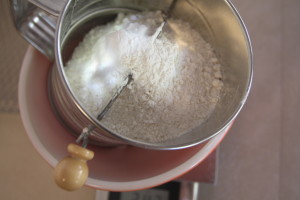
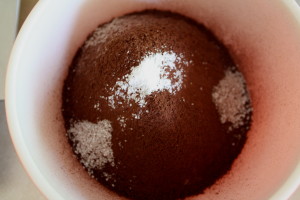
Sift dry ingredients. In a medium bowl, sift together cocoa, flour, and baking soda. With a scale, we just place the sifter right in the bowl, place it on the scale, hit tare, pour in the right amount of cocoa, hit tare again, then add the flour. Finally, we put the baking soda on top, and sift away. You’ll have a bunch of lumps of cocoa, so smoosh them through the sifter at the end. Then add the salt (kosher is too coarse to sift) and whisk the dry ingredients until uniform in color. Set aside.
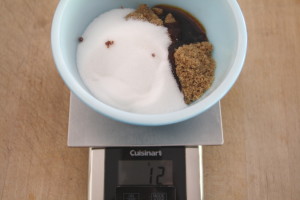
Measure sugars. We almost didn’t do this step, figuring that we could just pour the sugars into the mixing bowl when the time came. But, then we thought, all we’re saving by not measuring beforehand is the washing of one little bowl, so we measured. Again, we just placed the bowl on the scale, hit tare to zero, added the brown sugar, repeated for the granulated sugar, and did the same for the molasses. Weighing is the best for sticky ingredients like molasses; basically, you can slowly pour it in until you get just the right amount. Once measured, we stirred everything together, but there were still a few lumps. They’ll get broken up later.
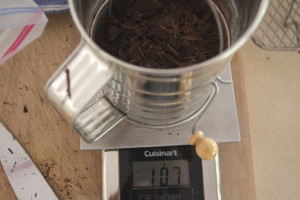
Chop chocolate. We took a chef’s knife to a block of chocolate, and we could see at once that we were going to have some pretty small shavings of chocolate, so we placed the sifter on the scale, and weighed out the proper amount of chocolate. Then we shook/rapped the sifter once or twice to shake out the smallest pieces of chocolate, and dumped the chunks into a measuring cup. Then we measured the chocolate chips right on top.
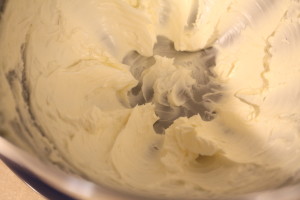
Beat butter. Place the butter in the bowl of a stand mixer fitted with the paddle attachment and beat on medium-low until the butter is smooth, shiny, and light, and holds peaks when the beater is lifted. If your butter is the right temperature, this should take about a minute; if not, it may take longer, or you may have to wait a bit longer for the butter to warm.
Cream in sugar. Add the sugar mixture and beat on medium-low until the butter and sugar mixture is light and fluffy, about 4 minutes. Yes, give it a spell of whirling in the mixer. If you’re like us, you’ll be impatient (why, we don’t know; it’s not as if it’s taking any effort to watch the mixer whirl around), but give it time.
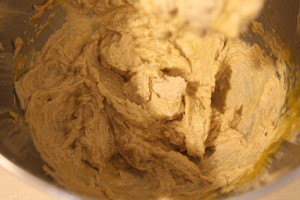
Add egg. Turn off the mixer, scrape down the sides of the bowl, and add the egg. Beat it in on low until it’s just incorporated, about 15 seconds. It’ll look as if the dough has broken, or separated, but this is okay.
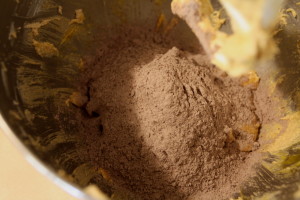
Add flour mixture. In two roughly equal additions, add the flour-cocoa mixture and beat on low until just incorporated. After each addition, scrape down the sides and bottom of the bowl to incorporate any flour that’s hiding.
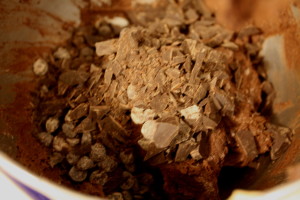
Add chocolate. Pour in the chocolate chunks and chips, and pulse the mixer about 10 times to mix. By pulsing, we mean just flick the mixer on and off quickly, which will prevent the mixer from crushing up all those chips and chunks.
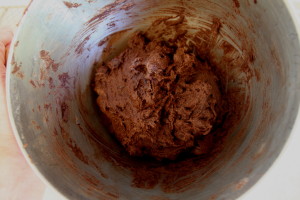
Chill. The dough will be really soft and difficult to work with now, so refrigerate it for 30 minutes to make it less sticky.
Preheat oven to 325°F. Line baking sheets with silicone baking mats or parchment.
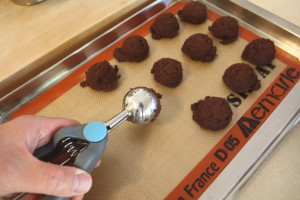
Portion. Naturally, you can make these cookies nearly any size you want. The book called for dividing the dough into six(!) equal portions. That would be way too much cookie for us — well, not really, but we did want more than a half-dozen cookies — so we scooped them out using a 1 1/2 tablespoon ice cream scoop, placing the scoops on the prepared sheets. Please note that we’re freezing our dough (see note below), so they’re close together. If you’re baking, leave about 1 1/2 to 2 inches between each cookie.
Bake. Slide into the oven and bake 15 to 17 minutes, rotating the sheets from top to bottom and front to back halfway through, or until the cookies look completely baked. It’s difficult to tell with dark cookies, but you don’t want any shiny spots on top of the cookies.
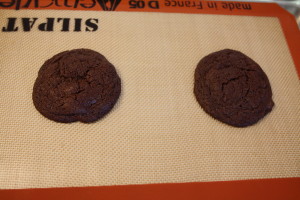
Cool. Let the cookies cool for 10 minutes on the baking sheets, then transfer to a baking rack to cool completely, provided you can wait that long.
Note. If you want, you can freeze the portioned-out dough for baking later. We do this with most cookies that we make just for us. Place the baking sheets in the freezer for about 30 minutes for the dough balls to freeze, then transfer to freezer bags. To bake, you can either let the dough thaw and warm to room temperature (recommended in the book), or just pop them into the oven and bake a few minutes longer (recommended by your Scratchin’ It team, who often want cookies ASAP).
We loved these cookies, but that isn’t really a surprise. We really don’t think that we’ve tried a Thomas Keller recipe that doesn’t just work exactly as the instructions say — even down to the timing on the mixer — and the result is always delicious, just as these cookies are. They’re full of chocolate flavor; the chunks stay slightly melted, even when cooled, and the chips add just a bit more bite. Then with the chocolate batter, ah, how can you go wrong? Sure, it might seem like a lot of trouble with all the precise weighing (or measuring), but for these cookies, it’s worth every gram. Five stars (if we had them, they’d be chocolate stars, too).
